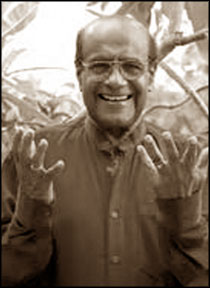You'll cry at The Outcry
Nilma DOLE
The renowned playwright, director and actor Namel Weeramuni will
launch his latest drama, `The Outcry' by Tennesse Williams.
Being a product of the Sarachchandra era, his maiden role was in one
of Prof. Sarachchandra's plays staged in 1959.
 |
|
Namel Weeramuni |
Namel later went to London to practise law, opening his own firm
which lasted for 29 years. He said "After my law stint, I studied
theatre at the State University of California, Northridge where I did my
Masters with Distinctions". Namel then proceeded to Hawaii and completed
a doctoral program in Theatre, after which he returned to Sri Lanka and
opened the `Punchi Theatre' at Borella.
Mark Hager and Hasini Erandika Somawardhana play the two principal
roles in the `The Outcry'. Mark acts as a playwright and lives with his
sister, a nympho actress played by Hasini. The siblings have been
traumatised and become highly schizophrenic ever since their father
killed their mother and then committed suicide. The play is sponsored by
the American Centre while the costumes and set designs are by Mark's
wife, Upeksha Hager. The lighting is managed by Prabath Manoharan.
Below are some questions director Namel Weeramuni answered about `The
Outcry' which will go on boards at the Punchi Theatre from the 22nd till
the 24th of May.
1. What wave of inspiration made you direct `The Outcry' by Tennesse
Williams? I am normally a person who likes to read and be active in
serious theatre and "The Outcry" is a piece of serious theatre. I read
this play originally as "The Two Character Play" somewhere in the latter
part of 1980s and ever since the content of it had been haunting in my
mind as I tried to understand what the play is about. I was attracted to
its `disconnected and complicated' structure.
I have read it over and again with the idea of directing it one day
and make it a success.
2. What sort of script is `The Outcry'? Please describe the "The Two
Character Play" concept.
It's a powerful piece of play about a brother and sister who are
touring as a theatre group from region to region. Williams describes it
as, "reality and fantasy interwoven with terrifying power as two actors
on tour - brother and sister - find themselves deserted by the troupe in
decrepit" state theatre in an unknown state. Faced (perhaps) by an
audience expecting a performance, they enact "The two Character play" -
an illusion within an illusion, an "outcry" from isolation, panic, and
fear. I think it is the most beautiful play since "A Streetcar named
Desire". On the surface, the play concerns a brother and sister, both
actors on tour in a small town. The other players and the company
manager have deserted them, and they are all alone and penniless. The
action, such as it is, takes place before, during and after a
performance of "The Two-Character Play," which involves the murder of a
mother by a father and his subsequent suicide." It is a play within a
play.
3. What makes Mark Hager and Hasini Somawardhana the two best
performers of their respective roles?
 They
are a marvellous combination of two characters. They are really
talented, hardworking, totally committed, intelligent, innovative and
inventive and punctual! At the outset it was their dedication and
interest in the play that I thought of having them as the ideal cast.
They have imbibed the theme of the play very well in their minds and are
real characters as I am sure, Williams has envisaged. I am lucky to have
them as a cast. They
are a marvellous combination of two characters. They are really
talented, hardworking, totally committed, intelligent, innovative and
inventive and punctual! At the outset it was their dedication and
interest in the play that I thought of having them as the ideal cast.
They have imbibed the theme of the play very well in their minds and are
real characters as I am sure, Williams has envisaged. I am lucky to have
them as a cast.
4. How does it apply to the Sri Lankan theatrical circles? Theatre,
wherever it is, in my opinion, has no boundaries. It is applicable in
terms of theatre only. It's a drug for those who crave for good and
serious theatre. Relevance springs out from the appreciation of good
theatre. It's fashioned by the technique and the structure of its
choreography that had evolved during its production process.
For a rich theatre tradition what I feel is that more and more
inventive serious theatre productions should come out like in countries
where rich theatre traditions thrive rather than cheap slapstick and
copycat stuff.
5. What sort of message do you want to convey via the drama?
It's a good question. What it reveals is that the theatre people
whoever they are - actors, actresses, authors, agents, audiences - are
trapped or imprisoned in theatre as projected by "The Outcry". The theme
is revealed through a `salacious, solipsistic spellbound, stage sorcerer
surreally sardonically, shamelessly, sadistically showcasing,
sanctifying and subordinating a stifled star-struck sleep-starved
seductive scene-stealing sister'.
|

